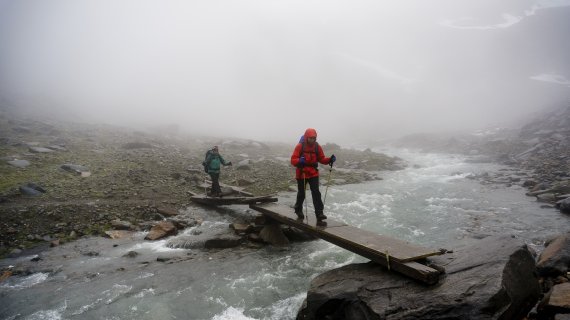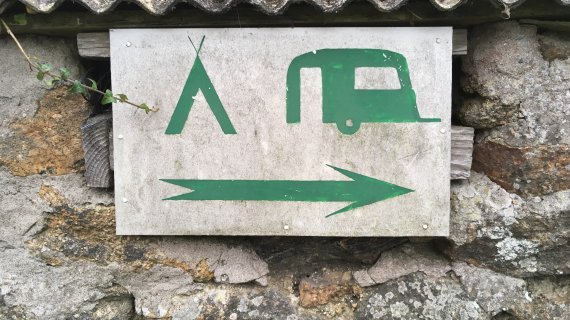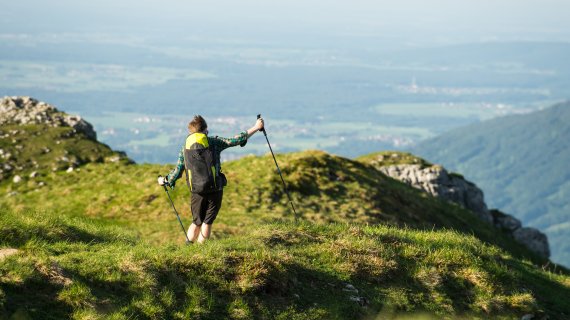Our author always thought hiking was for pensioners. For real adventures, you have to have at least one ice pick in your luggage. But the challenge can also lie in being on your own in the wilderness and looking for your own route far away from the paths. A cross-country test in the highest mountains of Scandinavia

The definition of an adventure can be interpreted individually. The trench at my feet is definitely manageable. Three, maybe four meters wide, knee-deep at the deepest point. It'll still do for wet shoes, though. So I carefully place my steps on the stones sticking out of the outrageously clear water and balance across the stream with silly arms spread out. After three days without a shower the thought of a dive has something seductive about it - but then please without the seventeen kilos of clothes, sleeping bag and food on your back.
Where I wanted to go with the big backpack, the nice older couple asked in the most beautiful Norwegian accent on the parking lot. West, very roughly, I replied. Somewhere between Lake Bygdin and the Olefjord. I did not mention, however, that I primarily want to avoid meeting people of advanced age with zip-off trousers and trekking poles (even if they are really dear to my heart).
There's nothing wrong with retirement. And certainly not hiking. But both are not exactly the epitome of adventure, and if you have grown up in German-speaking valleys and are familiar with the feeling that the queue to pancakes begins at the valley station, the desire to run in the mountains can pass you by.

But I'm not daring enough to just walk out the door with crampons. So where to put the mountain need? What lies between a walk at Spitzingsee and an oxygen mask at K2? In our case, it is the last snow remains of winter, which alternate with the flowering bushes of midsummer. The last three days Hansi, the photographer, and I have done nothing but put one foot in front of the other. Sometimes on dusty earth, sometimes on springy moss, then again on smacking moor and countless times on rock that shimmers in so many different facets of grey and green that fifty shades are not nearly enough. Most of the time we had the feeling of being the first people to enter this landscape.

Although there are 20,000 kilometres of hiking trails in this country and you could also make good meters along the stone pyramids, accurately piled up by the Norwegian hiking club with the red "T" markings, but it is supposed to be about adventure, not about checking off stages. In the end we won't be able to tell anyone how many kilometres we covered or how long it took us to get from A to B. Apart from the resolution to spend three days in the Norwegian wilderness, far away from huts and food, instead with tent and couscous, there is no plan. No route. No target. And no way.
And while I regularly have to remember that we are not walking through a photo wallpaper here, occasionally the thought that I should not stumble over the next root while looking into the landscape crosses my mind.
Since the landscape winds quite clearly around the mountain ranges, you can also walk off the beaten track without any problems. And while the number of people greeting with a friendly "Hej, Hej" was already limited on the hiking trail, only a few kilometres away there is really nobody to be seen, nobody at all.
No noise except the wind and the birds' constant background singing. Just your own kicks and the heavy breathing that pays tribute to the 52-litre backpack. There is no hut like in the Bavarian foothills of the Alps waiting behind every hilltop. Here, the wind does not carry the bass of the umbrella bar up the mountain like in Tyrol. Here, you catch yourself thinking that the distant noise is a motorway, only to notice that in reality it is a waterfall that transports the melt water into the valley. And that the cuckoo is actually real, and not another hiker's joke.


The quiet lakes and angular slate formations make you look up from your hiking boots again and again in disbelief. And while I regularly have to remember that we are not walking through a photo wallpaper here, occasionally the thought that I should not stumble over the next root while looking into the landscape crosses my mind. Civilization is one day's walk away, and even if the terrain is not particularly challenging, there is only one wrong step between a relaxed walk and a cracked ankle. And the seclusion we've been through would be limping and anything but beautiful.
Granted: Carrying a tent, equipment and food for several days through the countryside is more strenuous than I thought.
Between bright sunshine and crackling rain, there are sometimes only a few minutes in Norway. At night, the temperatures move around the freezing point, and those who notice too late that their fleece sweater is not in the backpack, but instead at home in the tumble dryer, can't even buy a replacement in the souvenir shop. The challenge of wild hiking is therefore not primarily physical. Granted: Carrying a tent, equipment and food for several days through the countryside is more exhausting than I thought. Especially when you have packed completely superfluous things like a headlamp, even though it doesn't get dark in the middle of the night in these latitudes in summer. It's not a simple walk.

But there are other things that matter. Discussing with the photographer, whether it is really a clever idea to pitch the tent at the top of the Bitihorn, even though the wind is so strong that it would have almost landed in the next valley. And then, after two hours of freezing, finally getting the confirmation that it was quite a stupid idea. As a result, we decided to dismount 200 meters in altitude, so we could have a more pleasant temperature in our sleeping bags at the windless foot of the mountain. You don't need the base camp of Mount Everest for this, 1600 Norwegian meters of altitude are enough - and yet hiking is suddenly anything but boring.
Of course, portioning the nuts and raisins in such a way that you don't have to fast on the last day, does not lead to starvation, as it does on Nanga Parbat. Nevertheless, after the second meal in the camping stove, I feel like an adventurer. Beginners, but adventurers. Because considering whether the water will be enough until we arrive at the river in the next valley, or should already be filled up here in the lake (from which one can drink in Norway fortunately without hesitation), leads either to a suddenly heavier backpack, or to unpleasantly dry throat, if the sun surprisingly comes out and T-shirt temperatures suddenly prevail.

If you have stubbornly followed yellow DAV signposts all your life, you must first learn to give your intuition room, if there is no right or wrong, when it comes to the question of whether you will pass the mountain ridge on the left or right. There is something liberating about getting involved in this kind of walking and literally letting oneself go a bit further. Not only from the compulsion to have to search the GPS track for the daily route before breakfast.
To be woken up in the morning not by the alarm clock, but by the sun feels right, no matter what time of day it is


To be woken not by the alarm clock but by the sun in the morning feels right, no matter at what time. Having only the clothing with you that lies in the drybag, makes it easy (even if your back claims otherwise). And to switch off your head at some point and simply follow your feet, because the goal is really only the way, lets you get there. Then the mixture of sweat, dust and sun screen, which you scrubs off your skin in the evening with ice-cold fjord water, becomes as proud a souvenir as a climbed summit.
Especially in Norway, where nature seems so out of time that you think you can still hear the big bang reverberating, you can get into thinking. About the walking, the sense and the nonsense of it. And next to a backpack full of dusty clothes, empty nut packs and an unused headlamp, after three days there is also the realization that hiking is simply what you make of it. And to set unelegante steps on wobbly stones in the river bed, that does as well work at home - guaranteed also when you're in retirement.




